![FACS analysis of THP-1 cells using GTX54458 CD163 antibody [RM3/1]. Black : Cell only control Red : Isotype control Blue : Primary antibody Antibody amount : 2 microg / 2.5x10? cells FACS analysis of THP-1 cells using GTX54458 CD163 antibody [RM3/1]. Black : Cell only control Red : Isotype control Blue : Primary antibody Antibody amount : 2 microg / 2.5x10? cells](https://www.genetex.com/upload/website/prouct_img/normal/GTX54458/GTX54458_20201207_FACS_4_w_23060900_445.webp)
FACS analysis of THP-1 cells using GTX54458 CD163 antibody [RM3/1]. Black : Cell only control Red : Isotype control Blue : Primary antibody Antibody amount : 2 microg / 2.5x10? cells
CD163 antibody [RM3/1]
GTX54458
ApplicationsFlow Cytometry, ImmunoFluorescence, ImmunoPrecipitation, Western Blot, ImmunoCytoChemistry, ImmunoHistoChemistry, ImmunoHistoChemistry Frozen, ImmunoHistoChemistry Paraffin, Neutralisation/Blocking
Product group Antibodies
ReactivityHuman, Monkey, Mouse
TargetCD163
Overview
- SupplierGeneTex
- Product NameCD163 antibody [RM3/1]
- Delivery Days Customer9
- Application Supplier NoteWB: 0.4 microg/ml. ICC/IF: 4 microg/ml. *Optimal dilutions/concentrations should be determined by the researcher.Not tested in other applications.
- ApplicationsFlow Cytometry, ImmunoFluorescence, ImmunoPrecipitation, Western Blot, ImmunoCytoChemistry, ImmunoHistoChemistry, ImmunoHistoChemistry Frozen, ImmunoHistoChemistry Paraffin, Neutralisation/Blocking
- CertificationResearch Use Only
- ClonalityMonoclonal
- Clone IDRM3/1
- Concentration100 ug/ml
- ConjugateUnconjugated
- Gene ID9332
- Target nameCD163
- Target descriptionCD163 molecule
- Target synonymsM130, MM130, SCARI1, scavenger receptor cysteine-rich type 1 protein M130, hemoglobin scavenger receptor, macrophage-associated antigen
- HostMouse
- IsotypeIgG1
- Protein IDQ86VB7
- Protein NameScavenger receptor cysteine-rich type 1 protein M130
- Scientific DescriptionThe protein encoded by this gene is a member of the scavenger receptor cysteine-rich (SRCR) superfamily, and is exclusively expressed in monocytes and macrophages. It functions as an acute phase-regulated receptor involved in the clearance and endocytosis of hemoglobin/haptoglobin complexes by macrophages, and may thereby protect tissues from free hemoglobin-mediated oxidative damage. This protein may also function as an innate immune sensor for bacteria and inducer of local inflammation. Alternatively spliced transcript variants encoding different isoforms have been described for this gene. [provided by RefSeq, Aug 2011]
- ReactivityHuman, Monkey, Mouse
- Storage Instruction2°C to 8°C
- UNSPSC12352203
References
- Chen L, Mei W, Song J, et al. CD163 protein inhibits lipopolysaccharide-induced macrophage transformation from M2 to M1 involved in disruption of the TWEAK-Fn14 interaction. Heliyon. 2024,10(1):e23223. doi: 10.1016/j.heliyon.2023.e23223Read this paper
- Ashenafi S, Muvva JR, Mily A, et al. Immunosuppressive Features of the Microenvironment in Lymph Nodes Granulomas from Tuberculosis and HIV-Co-Infected Patients. Am J Pathol. 2022,192(4):653-670. doi: 10.1016/j.ajpath.2021.12.013Read this paper
- Jing Y, Gao B, Han Z, et al. HOXA5 induces M2 macrophage polarization to attenuate carotid atherosclerosis by activating MED1. IUBMB Life. 2021,73(9):1142-1152. doi: 10.1002/iub.2515Read this paper
- Hamasaki S, Kobori T, Yamazaki Y, et al. Effects of scavenger receptors-1 class A stimulation on macrophage morphology and highly modified advanced glycation end product-protein phagocytosis. Sci Rep. 2018,8(1):5901. doi: 10.1038/s41598-018-24325-yRead this paper
- Kobori T, Hamasaki S, Kitaura A, et al. Interleukin-18 Amplifies Macrophage Polarization and Morphological Alteration, Leading to Excessive Angiogenesis. Front Immunol. 2018,9:334. doi: 10.3389/fimmu.2018.00334Read this paper

![IHC-Fr analysis of human interfollicular tissue of tonsil section using GTX54458 CD163 antibody [RM3/1]. IHC-Fr analysis of human interfollicular tissue of tonsil section using GTX54458 CD163 antibody [RM3/1].](https://www.genetex.com/upload/website/prouct_img/normal/GTX54458/GTX54458_20201207_IHC-Fr_15_w_23060900_231.webp)

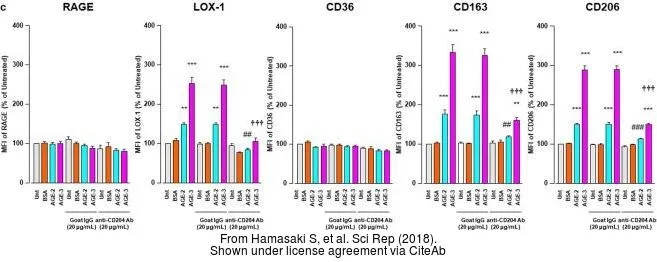
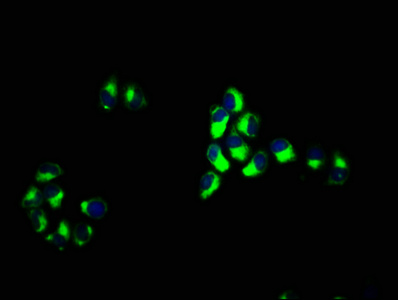
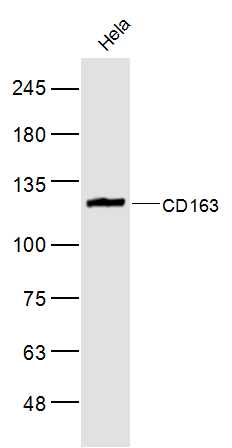

![WB analysis of human placental tissue lysate using GTX52614 CD163 antibody [6J58].](https://www.genetex.com/upload/website/prouct_img/normal/GTX52614/GTX52614_20191119_WB_w_23060900_981.webp)
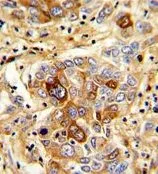
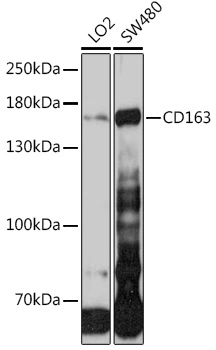
![IHC-P analysis of human tonsil tissue using GTX04717 CD163 antibody [10D6]. Antigen retrieval : Citrate Buffer pH 6.0](https://www.genetex.com/upload/website/prouct_img/normal/GTX04717/GTX04717_20240325_IHC-P_24032422_168.webp)